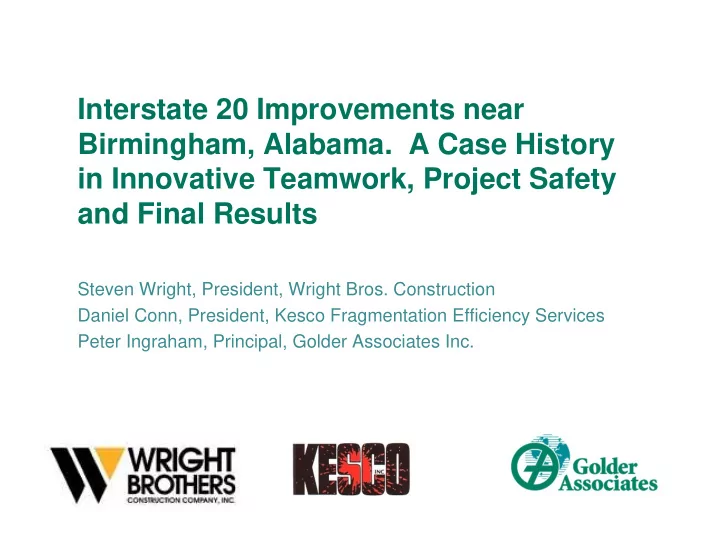

Interstate 20 Improvements near Birmingham, Alabama. A Case History in Innovative Teamwork, Project Safety and Final Results Steven Wright, President, Wright Bros. Construction Daniel Conn, President, Kesco Fragmentation Efficiency Services Peter Ingraham, Principal, Golder Associates Inc.
Introduction ‘Nothing in life is so exhilarating as to be shot at without result.’ Winston Spencer Churchill
Overview Aging Interstate rock slopes Past blasting practices and legacy issues Non-Geotech Design Review on Improvements Non-Construction Interests I-20 Design Development Rock Slope Concerns Design/Construction Modifications What was going to happen happened – without result. Acknowledgements – why it worked
Aging Interstate Rock Slopes
Aging Interstate Rock Slopes
NCDOT Photo Aging Interstate Rock Slopes
Past Blasting Practices and Legacy Issues
Past Blasting Practices and Legacy Issues
Past Blasting Practices and Legacy Issues
Past Blasting Practices and Legacy Issues
Past Blasting Practices and Legacy Issues
The worst that can happen
Interstate 20 East of Birmingham
Interstate 20 East of Birmingham
Interstate 20 East of Birmingham
Interstate 20 East of Birmingham
Interstate 20 East of Birmingham
Interstate 20 East of Birmingham
Interstate 20 East of Birmingham
Interstate 20 East of Birmingham
Interstate 20 East of Birmingham Cut is through sandstones and metaquartzite transitioning eastward to sandstone over shale Original construction cuts in hard units were steep – probably ~ 4-on-1 (65-75 degrees after aging) Shales standing at 60 degrees with shotcrete and 50 degrees unarmored Open bedding planes and joints on the face suggesting backbreak up to 30 feet. Initial Design (2003) had cuts of 20 to 30 feet westbound and 15 to 25 feet eastbound – project delayed by Katrina…
2003 Design (Sitz) for 2005-2006 Letting
Project Let in 2009 – awarded to Wright Bros.
I-20 Key Issues Project Arrangement and Setting High traffic volume (ADT~ 75000) on two-lane barrels Limited travelled lane offset from rock slopes Tall, slender cuts – all in backbreak - can only cast toward the roadway Observable wedge scarps open joints and thrust faults – would large wedges come out as before?
Addressing Key Issues Staging Construction – Constructing Eastbound side first to make room Adjusting slope angles to be shallower than geologic features. Shifting traffic to the new median to provide catchment at the toe of the westbound slopes Blasting at night when traffic was least intense (least impact to stakeholders) – you need a thinking blaster, not the cheapest….. Be prepared for a slow wedge failure – with room and equipment for rapid clean up.
Staging Construction – Constructing Eastbound Side First to Make room
Adjusting slope angles to be shallower than geologic features.
Shifting traffic to the new median to provide catchment at the toe of the westbound slopes
Blasting at night when traffic was least intense (least impact to stakeholders)
Blasting at night when traffic was least intense (least impact to stakeholders)
Be prepared for the slow wedge failure with room for catchment
Be prepared for the slow wedge failure with room for catchment
What was going to happen, happened – without result
Key Approach Elements for Success Ensure the slope design is kinematically stable; Consider Construction constraints – give the blaster room to turn the blast to cast parallel to live roadway MPT – work with traffic control to get active lanes as far as possible from blasting. Blast during off-peak hours. Stage Construction to accommodate adverse conditions Engage stakeholders, owner, designer, and contractor to work together to address difficult conditions.
What was going to happen, happened – without result We would like to acknowledge: Mike Harper, Asst Chief Engineer – ALDOT Terry McDuffie, Construction Engineer, ALDOT Buddy Cox, Alabama State Geologist Michael Mahaffey, Division Construction Engineer – ALDOT Gary Smith – Asst. Division Construction Engineer - ALDOT Mark Dison, Project Manager - Thompson Engineering Hunter Hudson, Lead Inspector – Thompson Engineering Michael Prince, Project Manager - Wright Bros. Paul Luker, Project Superintendent – Wright Bros. Mary Salyer – Project Engineer – Wright Bros.
Questions?
Recommend
More recommend